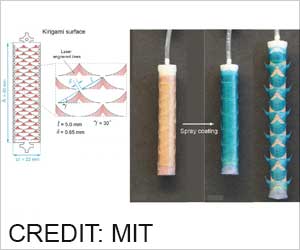says Giovanni Traverso, an MIT assistant professor of mechanical engineering, a gastroenterologist at Brigham and Women’s Hospital, and the senior author of the study.
‘New type of stent inspired by Japanese paper art kirigami could be used to deliver drugs to the gastrointestinal tract, respiratory tract, or other tubular organs in the body. The design of the stent helps in temporarily lodging it in the tubular organs to release targeted drugs followed by removal, thereby minimizing the side effects.’
Paper Inspired Stent as Targeted Therapy
Since the lodging of the stent in the GI tract can be tricky as the digested food is continuously moving through it, temporary insertion of the stent endoscopically followed by drug delivery and then easy removal serves the purpose just right. The localized delivery of the drug to the affected tissue thereby helps in curbing out the side effects encountered on other organs in the body.
The team tested the effectiveness of the stents in the esophagus of pigs by imparting microparticles containing a drug called budesonide, a steroid that is used to treat IBD and eosinophilic esophagitis.
The whole process took only a couple of minutes, and it was seen that the microparticles then stayed in the tissue and gradually released budesonide for about one week.
“The novelty of our approach is that we used tools and concepts from mechanics, combined with bioinspiration from scaly-skinned animals, to develop a new class of drug-releasing systems with the capacity to deposit drug depots directly into luminal walls of tubular organs for extended-release. The kirigami stents were engineered to provide a reversible shape transformation: from flat to 3D, buckled-out needles for tissue engagement, and then to the original flat shape for easy and safe removal,” says Sahab Babaee, an MIT research scientist, and the lead author of the paper.
The team had created kirigami needles of several different sizes and shapes along with the thickness of the plastic sheet. This helps in applying the technique to various sizes of the targeted tubular organs like blood vessels and the respiratory tract and their compartments. The team is now set to eventually test the stents in patients.
Source: Medindia



